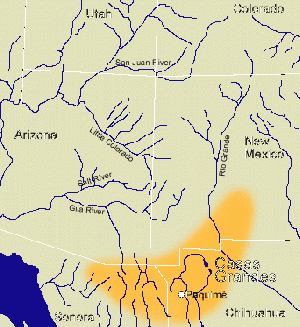Casas Grandes
Paquimé was the center of trade and activity for a large area during it's peak. The period of maximum construction is variously dated 1060 to 1340, or 1250 to 1340. Paquimé was burned around 1340. The ruins are near the modern town of Nuevo Casas Grandes, Chihuahua.
In many respects, Paquimé was a kind of hybrid or link between the cultures of Mesoamerica, in the center of Mexico, and the pueblo culture of the Anasazi, from the four corners area of Colorado, New Mexico, Arizona, and Utah.
From the Pueblo culture, the similarities include the T-shaped doors, T-shaped dooras well as the stone disks under the ceiling support columns. One interesting fact is that Chaco Canyon, Aztec and Paquimé are all aligned very accurately, relative to each other, on north-south axis. That is, they share the same longitude, with an error of a couple of miles, over a distance of more than 400 miles! The heights of the culture in the three places were sequential, with Chaco first, Aztec next, and Paquimé last. At their peak, each of these communities was by far the largest community for hundreds of miles. The archeologist Stephen Lekson builds on the similarities between the three sites to argue that the north-south alignment was not a coincidence, but had a ceremonial significance for the ruling elite, who moved from one site to the next.
From Mesoamerica, Paquimé had ballcourts, like the Aztecs and the Maya. The ballcourts were, however, relatively small compared to those found at Teotihuacán or Chichén-Itzá, or other major sites.
Paquimé, unlike Chaco or Aztec, raised macaws from the tropics, while Chaco and Aztec used macaws feathers in their ceremonies. Macaw PensThe small adobe structures were used for raising macaws and/or turkeys.
Characteristics
The people of Casas Grandes seem to have been more closely affiliated with the Mesoamerican peoples to the south than the Mogollon or Hohokam to the north. Platform mounds and ballcourts for ritual activities are characteristic features of Central American cultures at this time. Family groups lived along the river drainages, and developed extensive irrigation systems. The town of Paquimé was a major trading center, through which such luxury items as shells, copper, macaws and pottery made their way into Arizona and New Mexico from Central America.
House Types
Early Casas Grandes sites consist of groups of shallow pithouses arranged around a larger community house. Square contiguous surface rooms followed at a later period. The pithouses and surface rooms were constructed of an advnced form of jacal, a type of wattle-and-daub construction. The plaza grouping became more prevalent and probably housed lineages, groups of people with common ancestors. Ultimately, a form of poured adobe walls was developed.
Pottery
Early Casas Grandes pottery was similar to the red and brown wares of the Mogollon. These are often decorated with red geometric designs, usually banded. Later, distinctive polychrome varieties appeared, perhaps under the influence of West Mexican Nayarit or Jalisco pottery.

